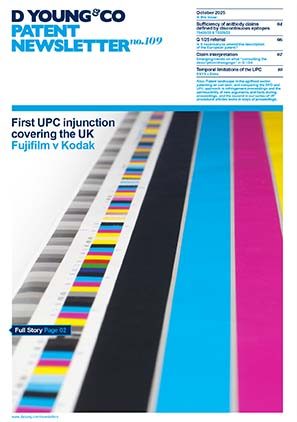FRAND licensing: what questions remain?
Now that the England and Wales Court of Appeal (EWCA) has upheld all substantive aspects of the first instance judgment in the case of Unwired Planet v Huawei, what problems remain for standard essential patents (SEPs) and their licensing?
Now that the England and Wales Court of Appeal (EWCA) has upheld [see note 1 below] all substantive aspects of the first instance judgment [see note 2 below] in the case of Unwired Planet v Huawei, what problems remain for standard essential patents (SEPs) and their licensing?
The specific challenge arising with SEP licensing is the balance of risks between hold-out (where an implementer continues infringing, relying on a FRAND commitment of the patentee making injunctions hard to obtain) and hold-up (where the patentee, having a monopoly right to an essential technology, refuses to license at an acceptable rate, or at all).
Good for the patentee
Arguably, Unwired Planet v Huawei comes down firmly on the side of the patentee in finding that in certain circumstances a worldwide licence can be FRAND and that, should more than one set of terms be considered FRAND, it is permitted for the patentee to insist on one of these. The FRAND nature of a worldwide licence was assessed at first instance based on a number of factors: all of the comparable licences were worldwide, it was clearly industry practice for willing licensees and willing licensors to agree to worldwide licences (anything else would have been inefficient and resulted in “madness”), and the Unwired Planet portfolio had broadly comparable geographical scope to those in the comparable licences.
The judge at first instance also held that a worldwide licence would not constitute anti-competitive bundling or tying based on CJEU case law, his own reasoning, and a lack of evidence which would be required to support a contrary finding.
The Appeal Court went further, explicitly addressing the risk of hold-out that could arise if the proprietor could not insist on a worldwide licence in one court, but instead would have to initiate proceedings in many jurisdictions to secure royalties.
In the 2017 CJEU judgment in Huawei v ZTE [see note 3 below], guidance was provided that an injunction could be issued if, in spite of reasonable behaviour by the patentee, the implementer did not progress in good faith.
Because the Huawei v ZTE judgment was delivered while the Unwired Planet proceedings were ongoing, the latter was considered a “transitional” case, and so care should be taken when considering the manner in which Huawei v ZTE was applied. However, Huawei may now find themselves with a UK injunction if they refuse to agree to a worldwide licence. At the appeal, Huawei repeatedly challenged this on the grounds that the only patents at issue were UK patents. However, the appeal judges rejected their arguments, as previously reported [see note 4 below], and refused permission to appeal to the UK Supreme Court.
Questions over the FRAND nature of a worldwide licence therefore appear to be largely settled, though other issues certainly remain.
Counting patents
As discussed previously [see notes 4 & 5 below] this case addressed head-on the challenges arising from the sheer number of patents involved.
Although never intended as a basis for setting royalty rates, the lists of rights declared to standards organisation have become a de facto starting point. Some commentators have suggested that over-declaration, whereby such lists include non-essential and/or invalid rights, is a problem that needs to be solved, however this is to misunderstand the primary purpose of the declarations. Some over-declaration is inevitable because standards organisations (such as ETSI) may require applications to be declared before they become granted patents, and rights to be declared before the standard is stable.
Both sides proposed approaches to deal with this, and while the judge did not find either objectionable in principle, neither was wholly satisfactory and both were very time-consuming and expensive. Evidence supporting claimed “essentiality ratios” is likely to be required in any future litigation to support proposed rates based on ‘top-down’ calculations or comparisons with other known portfolios.
Reliance on current industry practice
The appeal court endorsed the approach of the judge to assess FRAND terms based on “what a willing licensor and a willing licensee in the relevant circumstances acting without holding out or holding up would agree upon, general practice in the industry, and any relevant comparables”. Of course, concrete evidence for only the last two of these existed, and this was to be used to determine the first.
As such, the extent to which the specific findings in this case (particularly around the rate calculations) are fact-specific cannot be over-stated. Although the mobile telecommunications industry is large and global, the number of implementers is relatively small, and their products are (or at least, have been) broadly similar in nature (being either standards-compliant network equipment or mobile handsets). This meant that there were a large number of comparable licences available, and industry practice was well established and well understood.
Indeed, not only did the Unwired Planet judgment rely heavily on current industry practice to determine rates and terms, but the CJEU’s guidelines in Huawei v ZTE require the alleged infringer to “respond to that offer [from the proprietor], in accordance with recognised commercial practices in the field” (emphasis added) in order to avoid injunctive relief being granted.
However, the increasing variety in products using a particular technology, and the flexibility being provided in newer standards to support devices of different capabilities is going to make setting royalty rates for SEPs harder, not easier. As pointed out by Avanci, a patent pool targeting wireless communications for IoT: “the value of a license to wireless technology bears little relation to the $75,000 price tag for a luxury sports car or a $2,000 stainless steel refrigerator" [see note 6 below]. To address this, Avanci’s royalties “will vary … based on the value the technology brings to the device, not its sales price" [see note 7 below].
Further challenges may arise if the recent summary judgment [see note 8 below] in FTC v Qualcomm is relied upon by chipset manufacturers or participants in supply chains other than brand owners. In that case, the FTC sought, and obtained, a declaration that “Qualcomm’s voluntary FRAND licensing commitments to [ATIS and TIA] . . . require Qualcomm to make licenses available to competing modem-chip sellers”. Similar challenges arise from the IEEE’s 2015 update to its policy to require licensing at the smallest saleable patent practicing unit (“SSPPU”) level.
This raises challenges for licensees: first, many licensees will be seeking licences in respect of products (such as cars, or refrigerators) or components for which few, or no comparable licences exist. Second, which is “the field” to consider in the Huawei v ZTE guidelines – the automotive industry, the domestic appliance industry, or the consumer electronics industry? Third, end product sales price has been the conventional basis for determining royalties in wireless communications in the past but may make little sense in many new scenarios. The starting points (overall royalty burden for a mobile handset) in the top-down approaches used in both Unwired Planet and Ericsson/TCL would provide almost no help in such cases.
How then, could a court establish current industry practice should it be asked to determine royalties in new circumstances?
It is notable that in some ex-ante statements in respect of 3GPP 5G technologies [see note 9 below], licence rates for 5G-compliant mobile handsets are expressed in flat rate ($/€) amounts, rather than as a portion of sales price. This clearly simplifies some parts of the royalty calculations, but it does not solve the problem for other applications – indeed, the same companies are participants in the Avanci pool.
Conclusion
Unwired Planet v Huawei was undoubtedly significant in terms of the depth and breadth of analysis which took place, resulting in a complete, court-endorsed, licence agreement, and some principles are broadly applicably, particularly relating to the interpretation of the ETSI FRAND commitment interpreted according to French civil law. However, many practical aspects of SEP licensing remain challenging, and will get more complex as diversity of products and applications increases.
Notes & links to further information
- Full decision of [2018] EWCA Civ 2344: dycip.com/2018EWHC2344.
- Full decision (PDF) of [2017] EWHC 711 (Pat): dycip.com/2017EWHC711
- Full decision of C-170/13, Huawei v ZTE: dycip.com/c-17013
- D Young & Co article: www.dyoung.com/knowledgebank/articles/frand-appeal-huawei-unwired-planet
- D Young & Co article: www.dyoung.com/knowledgebank/articles/frand-california
- Avanci white paper (PDF): dycip.com/avanci
- dycip.com/avanci-pricing
- Federal Trade Commission v Qualcomm Incorporated No. 17-CV-00220-LHK (N.D. Cal.) (2018), Dkt. No. 931
- dycip.com/etsi-ex-ante-disclosures

